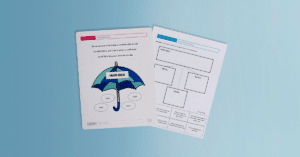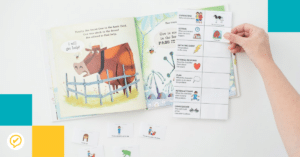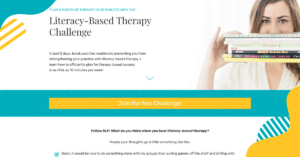I absolutely loved getting to “meet” thousands of SLPs at the SLP Summit. I was so inspired by all of the amazing presentations, but I was also inspired by YOU. I loved getting to chat with you every night. One viewer called it her “SLP Date Night,” which pretty much sums it up.
Wait? I missed this! What is the SLP Summit? Sarah and Lisa from SLP Toolkit and I hosted a FREE online conference for SLPs, featuring practical tips and resources for SLPs to start the new year off right. The recorded sessions will be available on the SLP Summit site through February 14th, 2017, so head on over if you haven’t already!
I presented on Practical Tips for Planning Effective and Engaging Therapy. We chatted about the four key components of a therapy plan.
Spoiler Alert: You’re probably doing more “planning” than you give yourself credit for–even if you don’t think of yourself as a planner!
My goal was for you to recognize all of the things you are already doing and then help you identify one or two specific strategies/tools to implement. There are an infinite number of things we could be doing, and it is easy to get overwhelmed. Start where you are, and go from there!
Because we ran short on time, I thought I’d take some time to answer the questions that I didn’t get to during the presentation. Let’s get started!
Step 1: Routine
Q: My goal is to have a routine, but my time management with moving from one group to the next has to change first! How do you manage?
A: Here are three strategies that have helped me:
1. Using a Time Timer really helps me make sure I have enough time to transition.
2. I set up my therapy cart to keep my materials organized and close by. (It makes it easier to clean up and set up, especially if students get the “routine” and are able to help.)
3. I shared Google Calendar appointments with my teachers. They can choose to get a notification five minutes before each session, which helps them remember to send their students and saves me a few minutes of running around the school.
Q: What do you do if they say they aren’t ready to learn? Send them back to class?
A: Not at all! If students aren’t “ready to learn,” it’s often because they are frustrated, sad, or tired. A quick joke or even just taking a minute to check in with them often does the trick. We might do a quick brain break or GoNoodle, if they need a little energy boost.
For more challenging students, collaboration with teachers is key. They often know the student best and are able to share strategies. (If not, then we can brainstorm together.)
Q: Do you send homework every session?
A: Confession. I’m not very good at homework! I really struggle A) to put homework packets together and B) to get students/parents to complete the activities.
However, I started using Remind this year. It’s a free messaging app, and I’ve had a lot of success with it! I’m able to share what we did in speech and include a quick idea for how parents can continue to support the skill(s) at home. It also helps open up communication with parents and increases their buy-in. Stay tuned for a blog post with more details!
Step 2: Data
Q: Where can I find your data sheets?
A: They are included in the SLP Now Membership, but they’re also FREE on Teachers Pay Teachers.
Q: Do you take data every session or at progress report time?
A: I take “data” every session. However, it’s not always numerical data. Sometimes it’s more helpful for me to know how much support a student needed and what types of cues were most helpful. (I do use a Level of Support Rubric to make sure that I’m being consistent!) Especially since stimulus items vary from session to session (e.g., difficulty of vocabulary in a book, complexity of articulation targets), I find that numerical data isn’t always the most helpful indicator. I will occasionally probe skills at the beginning of the session to help drive my therapy planning (if I’m unsure of where to go next).
Q: How do you take data during literacy-based activities?
A: I’ll write more about this in a future blog post, but the above answer describes my general approach. I tend to focus on narrative data describing the level of support the student needed to be successful.
Q: Do you take data for all responses or for just a set number of responses (for example five, 10, etc.)?
A: See above. However, when I do take more numerical data, I typically take data on the first 10 trials. I like this approach because it’s more like the “probes” they taught us to use in graduate school. It gives me an idea of whether the student is retaining the skill or not. It also allows me to slide the data binder out of the way and focus on the student(s) for the rest of the session.
Q: Do you find that if you’re doing sticker labels for your caseload that it gets expensive?
A: Not at all! They have some very inexpensive options on Amazon.
Step 3: Materials
Q: I love your therapy cart! Tell me more?
A: Thanks! I wrote about it here.
Q: Is the SLP Now Membership just for materials? Like the skill-based packs?
A: The membership does include therapy resources (e.g., theme- and skill-based activities), as well as organizational tools and a supportive SLP community. I’m also working on building a database of video tutorials and other resources. You can find out more about the membership here.
Q: Is there a trial for the SLP Now Membership?
A: Yes! Click here to sign up.
Q: What grade levels is SLP Now for?
A: The themed books and activities are most appropriate for preschool and early elementary caseloads, although the reading passages are written at an upper elementary level. The skill-based packs can be used with any student working on a given skill (e.g., basic concepts, categories, object functions, synonyms, context clues, inferences, etc.). We are working hard to expand the range of materials, including more resources for preschoolers, secondary, and more severely impacted students.
Q: When you have a membership to SLP Now, can you access previous months’ content, or just one month at a time?
A: It depends! Monthly members will have access to all the resources posted since their sign up date. Yearly members have access to all content posted on the site.
Q: You mentioned a book list. Where can I find this?
A: You can find my list of favorite themed books here. Book guides and activities will be posted in the SLP Now Membership for the majority of the books listed.
Q: Can I use DonorsChoose to purchase the SLP Now Membership?
A: Yes! You would just need enough points to purchase from an outside vendor. Find out more here.
Q: I love the rainbow “GRAMMAR” sign and other labels. Are those in membership?
A: Not yet! They will be soon.
Q: Your grammar board/pocket chart is awesome! Any resources on how to make this?
A: I will be writing a blog post soon!
Q: How do you use dry erase on the tables without leaving a big blob mess?
A: I just write on the table, and it comes off with an eraser. (I also wipe down the tables at the end of the day.) If you happen to have a super “blobby” table (they exist!), you can also use dry erase decals.
Q: Is EET appropriate for middle schoolers?
A: You can find out more here.
Q: Where do you find reading passages?
A: Here are some of my favorite sites:
NewsELA
ReadWorks
Reading A-Z
News-2-You
Step 4: Planning
Q: Do you plan the whole week or session by session?
A: My goal is to plan for the whole week, but that doesn’t always happen! I plan for at least a day at a time to save myself some time. (This allows me to batch copies and/or gather materials.)
Q: How much time do you spend planning for therapy?
A: With all of the other components taken care of (routine, data, and a core set of materials from the SLP Now Membership), I spend about 10 minutes planning for a week of therapy. I’m putting together a video tutorial so you can see exactly what that looks like.
Q: I really liked the set up of the paper planner you showed. Where did you get it?
A: I found that planner on Amazon.
Q: Is Google HIPAA/FERPA compliant?
A: We want to be careful with the information we share on Google. I never include a student’s full name (typically only initials). I also avoid storing personal identifiers (e.g., student ID, birth date, etc.). You can read more about Google security here. If you are unsure, then contact an administrator in your district or work setting.
Q: What is a Text Expander? How do I set this up?
A: I wrote a blog post here.
Miscellaneous
Q: How many goals do your students have on average?
A: It depends on the student’s needs, but most of my students have 2-3 goals.
Q: What planner do you use?
A: I most consistently use Google Calendar and Asana. (Read more about my favorite digital tools here.) I do have a planner addiction and own the following… I’m working on picking ONE. Stay tuned to see which one wins…!
Erin Condren
Moleskine Planner
ban.do Planner
Day Designer planner from Target
Ultimate SLP Planner
Thank you again for all of your support! We absolutely loved this event!
Feel free to leave any additional questions in the comments!
I’d also love to hear/see how you’re implementing these ideas in therapy! Check out what some rockstar SLPs are doing… 🙂






Leave a Reply